Prepare your boxes of patisseries for King Louis’ birthday. Royal flavors are preferred, and make sure you avoid allergens!
What Is Macaron?
Macaron is a trick-taking game for 1 to 5 players, ages 10 and up, and takes about 45 minutes to play. It’s currently seeking funding on Kickstarter, with a pledge level of $20 for a copy of the game, with higher tiers available that include 1 to 6 expansions. The trick-taking has a few twists from standard trick-taking games, so it’s a little more complex than Spades, but I think 10 and up seems about right, younger if your kid has some experience with trick-taking already. The theme is about making boxes of cookies, so there’s nothing inappropriate for younger audiences.
Macaron was designed by Ta-Te Wu and published by Sunrise Tornado Game Studio, with illustrations by Rachel Kim and Holly Chiu.
New to Kickstarter? Check out our crowdfunding primer.

Macaron Components
Note: My review is based on a prototype copy, so it is subject to change and may not reflect final component quality. For instance, the prototype only includes components for up to 4 players, though the final game will go up to 5. I’ve also included some screenshots of the game from Tabletopia.
Here’s what will come in the game:
- Game board
- Start Player marker
- Allergen marker
- Royal marker
- 10 Meeples (2 per player)
- 5 Betting tokens (1 per player)
- 13 Voting tokens
- 52 Macaron cards
- 4 Flavor Group cards
The components are, for the most part, fairly straightforward: cards, a small board, and some tokens. The tokens in the final game may look different than what you see here, and the betting tokens will match the meeples more closely, but the illustrations on the cards and board are more close to final.
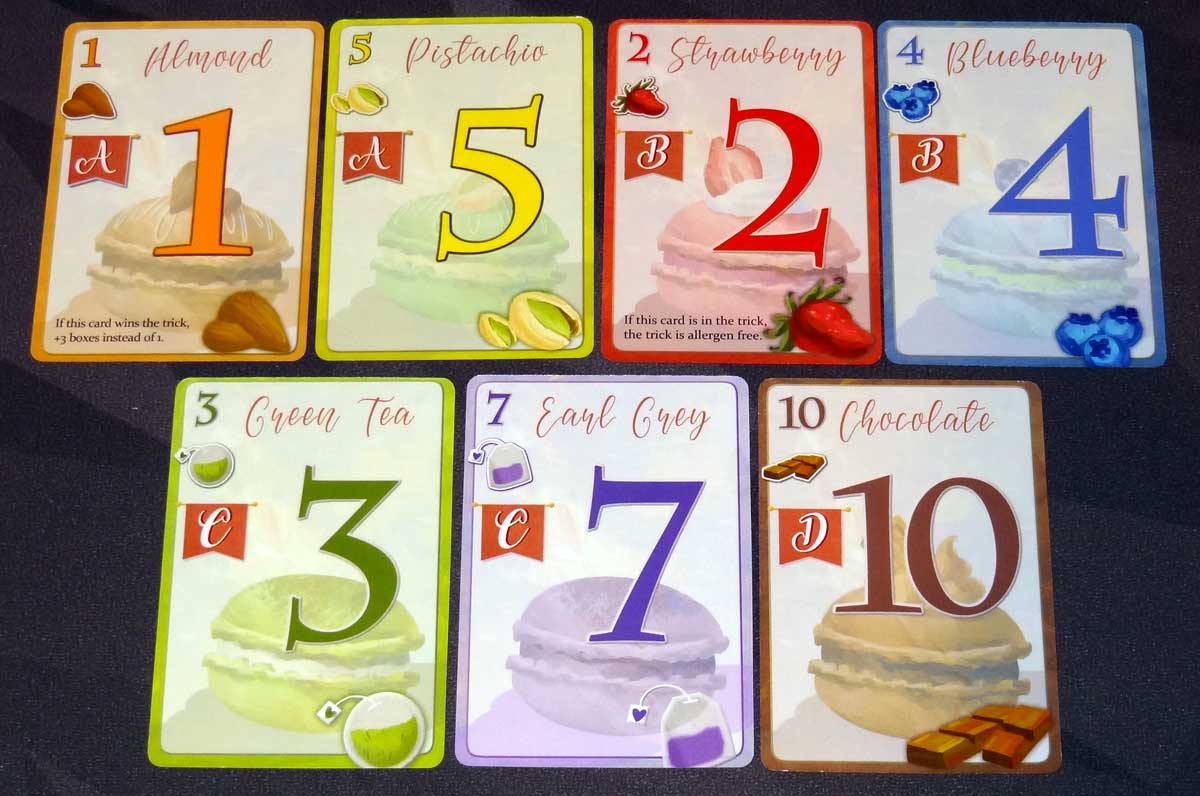
The cards themselves are pretty easy to read: each one has its value printed prominently in the center (over an illustration of a delicious cookie), with the flavor name and icons in a few places, plus the group letter in the middle left. The 1 and 2 value cards have some additional effects, which are printed at the bottom of the cards. Have trouble remembering the difference between a macaron and a macaroon? Now you know: macarons are the sandwich cookies as in this game, and macaroons are the coconut cookies that are nowhere to be seen.

The game board includes a score track around the outside decorated with all sorts of patisseries. The center of the board shows a set of gift boxes along with some other icons that are used for scoring each round. The board is double-sided, with the back used for the advanced game. It’s a fairly small board, and so the entire game box is fairly compact, smaller than your average hardcover novel. (Depending on stretch goals, this may be upgraded to a larger size folding board, but currently it’s the size of the box.) My only complaint about the board is that the gift box icons, where you put the meeples, are small enough that it can be hard to fit even 4 of them on the same space—with 5 players, it may get a little messy.
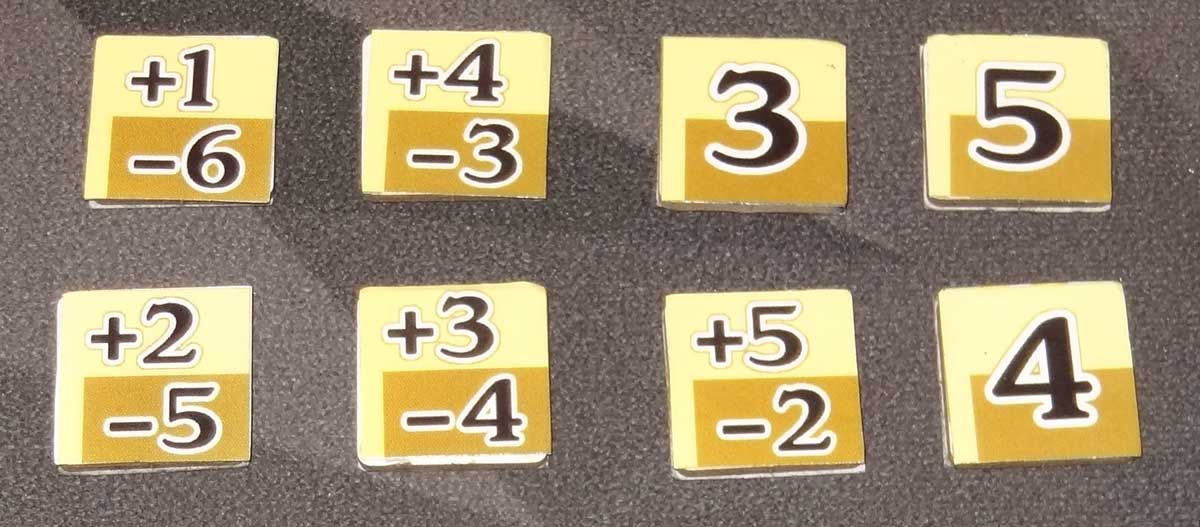
The voting tokens will look fancier in the finished game, but basically they have numerical values on them. Some have a single number; others have two numbers, one positive and one negative. These are used in the 4- or 5-player game to determine the royal group and the allergen.
How to Play Macaron
You can download a draft of the rulebook here. It’s also available to try on Tabletopia.
There are some differences in the rules depending on player count—I’ll explain solo rules separately, but just mention changes that are made between 2–3 or 4–5 players.
The Goal
The goal of the game is to be the first to reach 10 points on the victory track. (The game can also be played with higher goals of 20 or 30 points.)

Setup
Place the game board in the center of the table: everyone puts one meeple on the “0” of the score track, one meeple on the “0” gift box, and the betting tokens near the top right section of the board. Place the group cards nearby: For 4 or 5 players, use all four group cards; for fewer players, use only A, B, C and flip the C card to the side that only has one flavor.
For 4 or 5 players, you will also distribute the voting tokens; one “3” token is set aside and the rest are mixed up and dealt out evenly. One voting token doesn’t have a number on it and indicates the first starting player—that player swaps it out for the “3” token that was set aside earlier.
Prepare the macaron deck, shuffling together all the flavors that are included for the game. Deal 13 cards to each player. Each player passes 2 cards to their neighbor (alternating between passing left and right each round).

For 4–5 players, you will now vote for the flavors: in turn order, each player places one voting token face-down above or below a single flavor. Each flavor may only have a total of 3 tokens assigned to it. Once everyone has used all of their voting tokens, they are revealed and the royal group and allergen flavor are determined. Tokens placed above a flavor use the positive value, and tokens placed below a flavor use the negative value; if there is only one number, it is positive above and negative below. (You cannot vote for chocolate, Group D.)
The group with the highest net total is the royal group, and ties go to the group with the most positive votes, and then to the group farthest to the left. The individual flavor with the lowest total is the allergen, with ties going to the flavor with the most negative votes, and then to the flavor farthest to the left.

For 2–3 players, choose a start player at random (or the player who most recently ate a macaron). The second player chooses the royal group, and the third player chooses the allergen.
Note that it is possible for the allergen to be in the royal group, in which case that particular flavor is both!
Now, players in turn order may also bet: based on their hand cards, the royal flavor, and the allergen, players may optionally place their betting tokens on the coffee icons on the right side of the board. You are betting on which row of boxes you will end this round, based on the number of boxes you make. Correct bets will score bonus points, and incorrect bets will suffer a penalty.
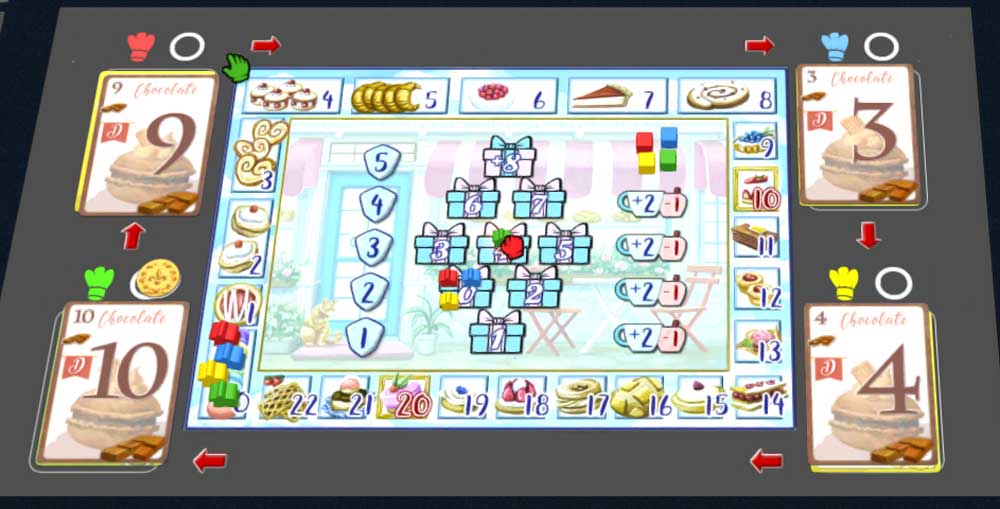
Gameplay
Now the actual trick-taking begins!
Each trick, every player will play one card from their hand in turn order. The first player may play any card, and everyone else must play the same flavor if possible. If you don’t have the starting flavor in your hand, you may play any card. The player with the highest card of the starting flavor wins the trick and makes a gift box, though there are some exceptions.
First, flavors in the royal group act as trump cards: a royal flavor beats any non-royal flavor. In the case of two royal cards with the same value, the one played earlier wins the tie. If a trick starts with a royal flavor, then the other royal flavor cannot win, regardless of the value.
If the trick contains any cards of the allergen flavor, you can still win the trick but you do not get any gift boxes. However, the “2” (regardless of its flavor) is a special card that cancels out any allergens in the trick. Think of it as an epi pen, so then you get a gift box as usual.
If you win a trick with a “1,” you get 3 gift boxes instead of 1.
Gift boxes are tracked on the center board—just move your meeple to the corresponding number as you make gift boxes.
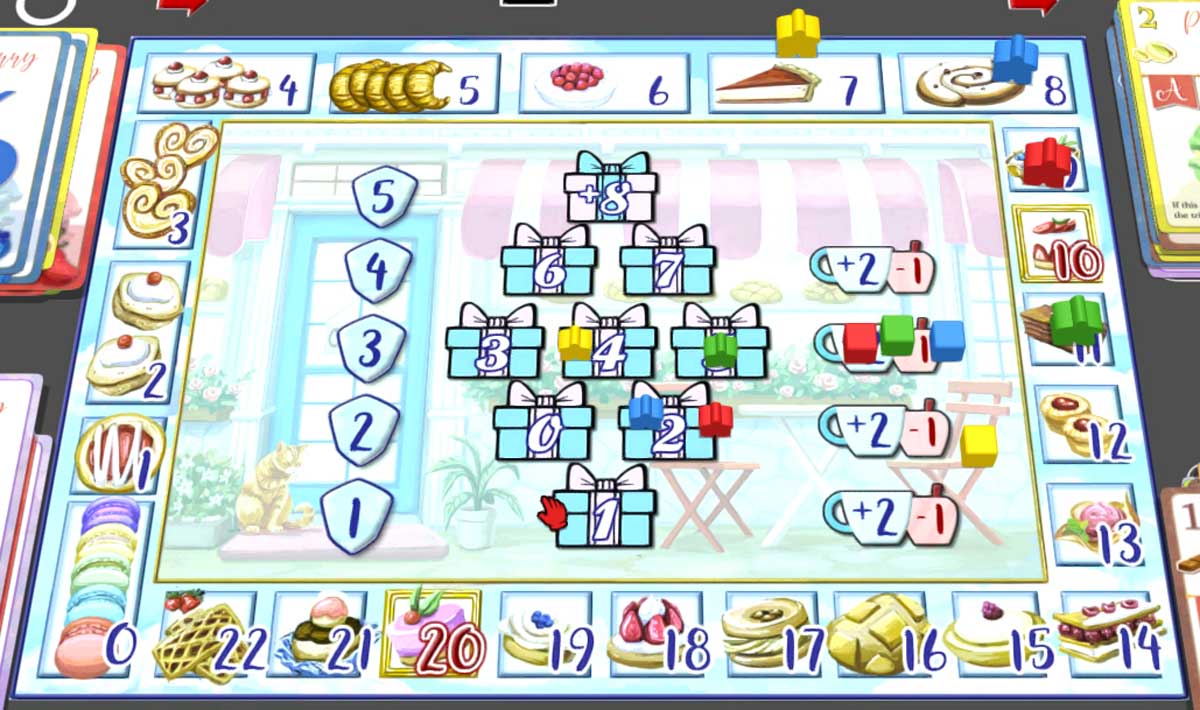
The round ends when everyone is out of cards. First, each player scores points based on the number of gift boxes they made, referring to the shield icon. For instance, in the image above, yellow and green would both get 3 points, because they made it to the center row, even though they have a different number of gift boxes. Then, if you made a bet, you score bonus points if you were right (shown in the blue mug), and lose points if you were wrong (shown in the red cup). In the image above, green scored 2 bonus points, but everyone else bet incorrectly and lost a point.
If nobody has hit the target score yet (10 is the default), then you follow the setup for another round. Basically everything except the scores are reset as in the initial setup.
Game End
The game ends when a player hits the target score. If more than one player reaches the target, the player with the higher score wins; there is no tie-breaker rule.
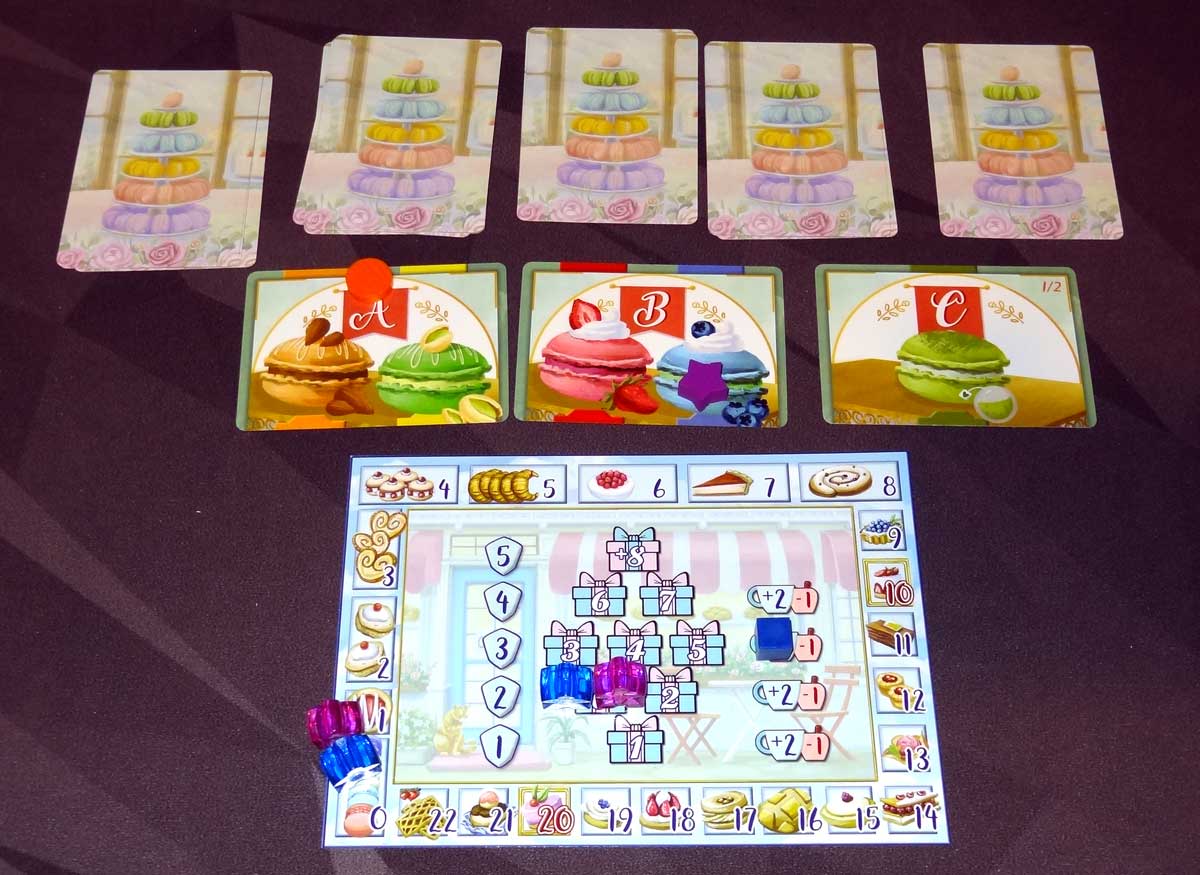
Solo Rules
The solo game pits you against an automated player named Emma. You don’t use the voting tokens, and you must make a bet each round—if you’re wrong, you don’t lose points, but Emma gets 2 points.
When you set up your hand, you deal yourself 13 cards, and then discard 2 and draw 2 from the deck. Then, you first deal 1 card face-down to each flavor (putting them above the group cards to keep track). Then, you deal out 8 more cards, placing them into the stacks according to their correct flavors. Shuffle each flavor stack individually.
The royal group is the one that Emma has the most total cards in, and the allergen is determined by revealing the next card in the deck.
Emma follows a particular set of rules to determine which flavor she will play each round: she follows suit when you lead if possible, but will respond differently to allergens and royal flavors if she doesn’t have any cards in that stack. If she wins a trick and will lead, there are also some rules to determine which flavor she will lead with.
Her flavor stacks may include cards that don’t actually match the flavor (because of the 5 random cards dealt at setup), but when played they are treated as if they’re the correct flavor. If both players play the same value card of the same flavor, the earlier player wins the trick.
Your goal is to score more points than Emma.
Why You Should Play Macaron
Trick-taking is a classic card game genre that has been around for a long time in games like Bridge, Spades, and Whist, but in recent years it’s been showing up in more modern card games as well. They differ from the classic games to varying degrees, and it’s been a lot of fun to explore these newer structures built on an old foundation.
Macaron has some familiar rules: following suits, trump suits, and bidding on how many tricks you think you’ll take. One of the new twists is that there’s usually more than one trump suit, because you have a royal group. The way that the two royal suits interact with each other (for instance, that you can’t use a different royal flavor to beat the starting royal flavor) make for some tricky prediction when you’re looking at your hand of cards.
The allergens are another twist, making a trick worthless to the winner. It reminds me a little bit of Hearts, since you typically want to avoid winning hearts, but in this case there’s no way to shoot the moon and turn those into positives—they’re just zero. Because of that, the allergen cards can be a great way to slough cards. It’s common to encounter a situation where you can’t follow suit, but you also can’t win with a trump card (either because you’ve run out or because somebody else has played a higher card). In Macaron, the allergens let you trash the trick—as long as nobody played a “2” to cancel the allergens.
The betting is similar to other trick-taking games, but not exactly. The number of gift boxes is grouped, so you don’t have to bet on an exact figure, but just a range. What’s interesting is that 0 and 2 are in a group, and 1 is by itself at the bottom of the scoring chart. That means you can get more points, betting aside, by winning no tricks at all than by winning just one. And, of course, if you make a bet, you can score even more if you’re right.

The back of the game board, which can be used for experienced players (or for longer games of up to 20 or 30 points), has a different breakdown of the gift boxes. 1 gift box is still the lowest scoring option, but now the bonuses and penalties are a little different—betting on 0 gift boxes and being correct is now worth 5 points total, but 0 if you miss. You can also now bet on getting 8 or more gift boxes, but there’s also a 2 point penalty for being wrong.
The other wrinkle that can play with your bets is the special power on the “1” cards, giving you 3 boxes instead of 1. There are two ways to win with a “1”: lead a trick with it when nobody else is able to follow suit (and nobody can beat it with a royal flavor), or use it as a royal flavor in a trick started with a different flavor—as long as nobody plays a higher royal flavor! It’s difficult to pull off, but if you have a royal “1” in your hand, it can also make betting pretty tricky, since it’s a 3-box swing. If the rest of your hand is mediocre and you think you’ll only make 2 boxes, winning with a “1” shoots you right past that target.
The chocolate flavor has more cards than the others—it goes to a maximum of 10 instead of 7. However, it can never be a royal flavor or an allergen, so it’s always just a regular suit—it can be hard to win a lot of tricks with chocolate, so you have to be careful how to count them in your betting.
As far as trick-taking games go, Macaron is on the shorter side if you play to 10. It’s possible—and I’ve seen it happen—for a player to win the game after just two full rounds, so it’s good that there are options to play to 20 or 30 points instead. Because of the way the multiple royal flavors work, I think this is one that may work best with players who have some experience with how standard trick-taking games work already, since they’ll have a leg up on figuring out how to handle trumping or sloughing cards.
Macaron is very cute: it’s a lot of pastel colors and scrumptious desserts, and a light-hearted theme has been a refreshing respite from the current state of things. For trick-taking fans, the game is like the cookie: petite and delightful, and hard to quit after just one taste.
For more information or to make a pledge, visit the Macaron Kickstarter page!
Click here to see all our tabletop game reviews.
![]() To subscribe to GeekDad’s tabletop gaming coverage, please copy this link and add it to your RSS reader.
To subscribe to GeekDad’s tabletop gaming coverage, please copy this link and add it to your RSS reader.
Disclosure: GeekDad received a copy of this game for review purposes.





